This is named after the High Cross, which stood outside this pub. At the point where Highcross Street meets High Street, outside this pub, some granite sets are laid into the road in the shape of a cross. This marks the site of the High Cross, the centre of medieval Leicester. The cross was actually the last remaining pillar of the old Market House.
Prints and text about The High Cross.
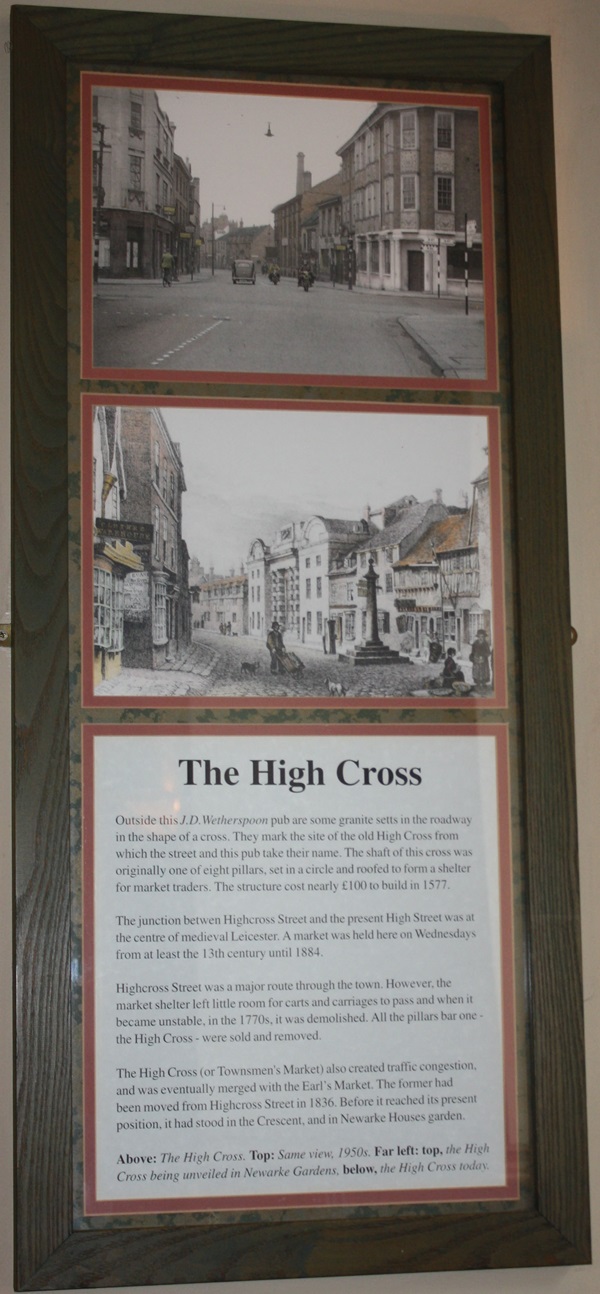
The text reads: Outside this J.D. Wetherspoon pub are some granite setts in the roadway in the shape of a cross. They mark the site of the old High Cross from which the street and this pub take their name. The shaft of this cross was originally one of eight pillars, set in a circle and roofed to form a shelter for market traders. The structure cost nearly £100 to build in 1577.
The junction between Highcross Street and the present High Street was at the centre of medieval Leicester. A market was held here on Wednesdays from at least the 13th century until 1884.
Highcross Street was a major route through the town. However, the market shelter left little room for carts and carriages to pass and when it
became unstable, in the 1770s, it was demolished. All the pillars bar one - the High Cross - were sold and removed.
The High Cross (or Townsmen's Market) also created traffic congestion, and was eventually merged with the Earl's Market. The former had
been moved from Highcross Street in 1836. Before it reached its present position, it had stood in the Crescent, and in Newarke Houses garden.
Above: The High Cross
Top: Same view, 1950s
Far left: top, the High Cross being unveiled in Newarke Gardens, below, the High Cross today.
Mixed media artwork entitled Highcross Relocated by local artist Chandrika Laad.
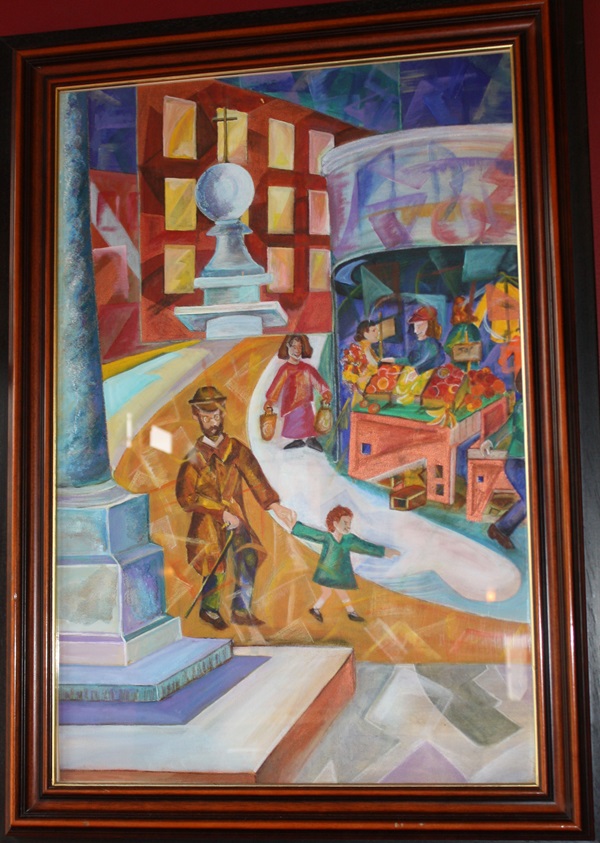
The text reads: 1780 saw the dismantling of the monument and its significance. It reverted back to a single column and was moved to various spots around Leicester since 1836. In 1976 this column found its way to its present location beside the 'Saturday market' at Cheapside.
Mixed media artwork entitled Medieval Highcross by local artist Chandrika Laad.
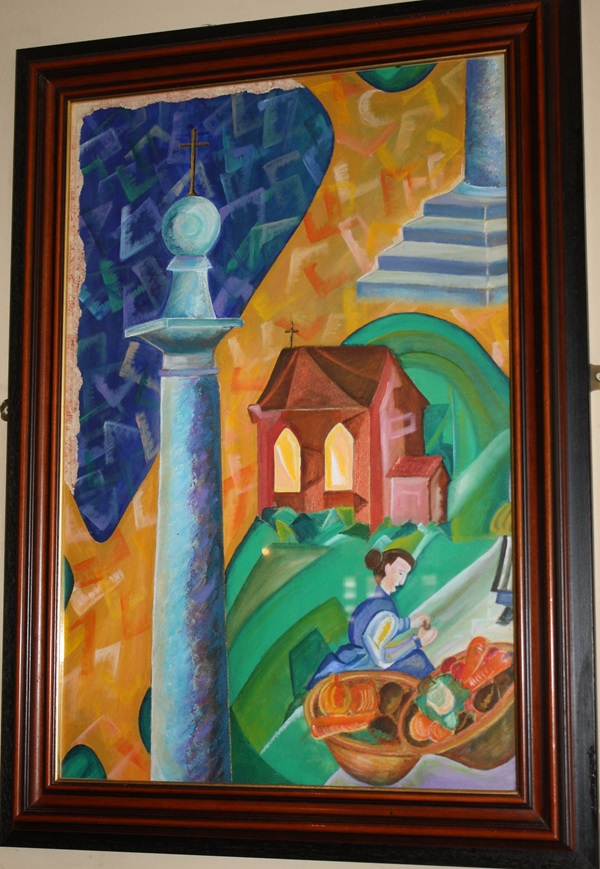
The text reads: This painting represents Highcross Street and the Highcross monument in the ancient parish of All Saints'. The High monument has been in existence from at least 1278 and it marked the heart of Leicester and the spot of the Wednesday market which remained on Highcross Street until 1884
Prints and text about The Free Grammar School.
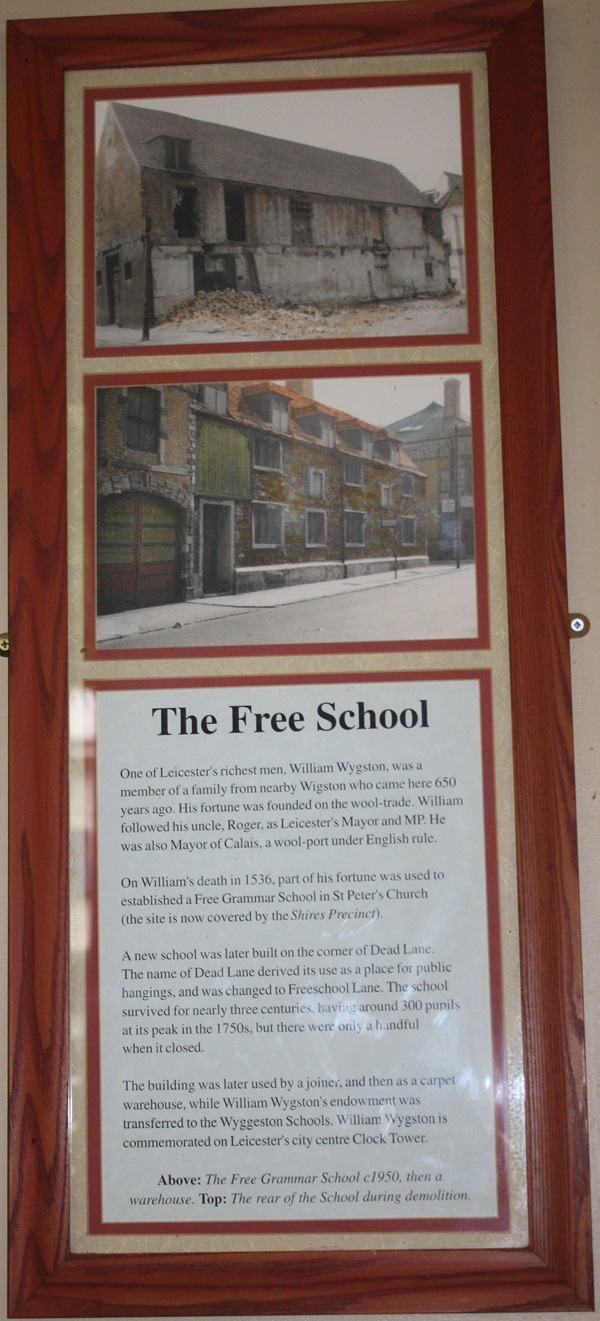
The text reads: One of Leicester's richest men, William Wygston, was a member of a family from nearby Wigston who came here 650 years ago. His fortune was founded on the wool-trade. William followed his uncle, Roger, as Leicester's Mayor and MP. He was also Mayor of Calais, a wool-port under English rule.
On William's death in 1536, part of his fortune was used to establish a Free Grammar School in St Peter's Church (the site is now covered by the Shires Precinct).
A new school was later built on the corner of Dead Lane. The name of Dead Lane derived its use as a place for public hangings, and was changed to Freeschool Lane. The school survived for nearly three centuries, having around 300 pupils at its peak in the 1750s, but there were only a handful when it closed.
The building was later used by a joiner, and then as a carpet warehouse, while William Wygston's endowment was transferred to the Wyggeston Schools, William Wygston is commemorated on Leicester's city centre Clock Tower
Above: the Free Grammar School c1950, then a warehouse
Top: the rear of the School during demolition.
Prints and text about John Jonson.
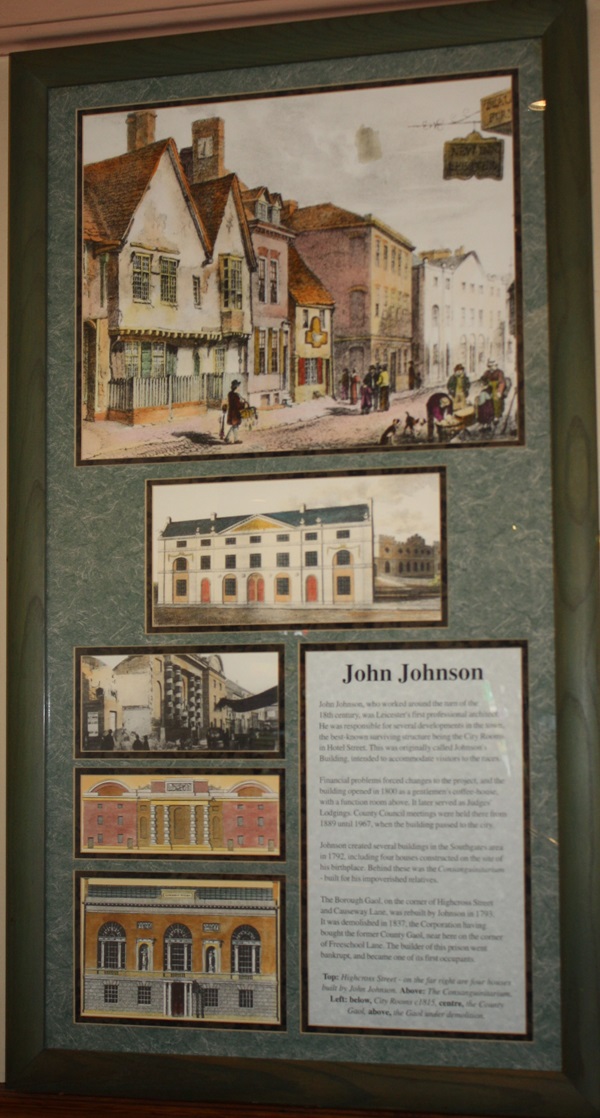
The text reads: John Johnson, who worked around the turn of the 18th century, was Leicester's first professional architect. He was responsible for several developments in the town, the best-known surviving structure being the City Rooms in Hotel Street. This was originally called Johnson's Building, intended to accommodate visitors to the races.
Financial problems forced changes to the project, and the building opened in 1800 as a gentlemen's coffee-house with a function room above. It later served as Judges Lodgings. County Council meetings were held there from 1889 until 1967, when the building passed to the city.
Johnson created several buildings in the Southgates area in 1792, including four houses constructed on the site of his birthplace. Behind these was the Consanguinitarium - built for his impoverished relatives.
The Borough Gaol, on the corner of Highcross Street and Causeway Lane, was rebuilt by Johnson in 1793. It was demolished in 1837, the Corporation having bought the former County Gaol, near here on the corner of Freeschool Lane. The builder of this prison went bankrupt, and became one of its first occupants.
Top: Highcross Street - on the far right are four houses
built by John Johnson
Above: The Consanguinitarium
Left: below, City Rooms c1815, centre, the County
Gaol, above, the Gaol under demolition.
Prints and text about Nathaniel Corah and the textiles industry.
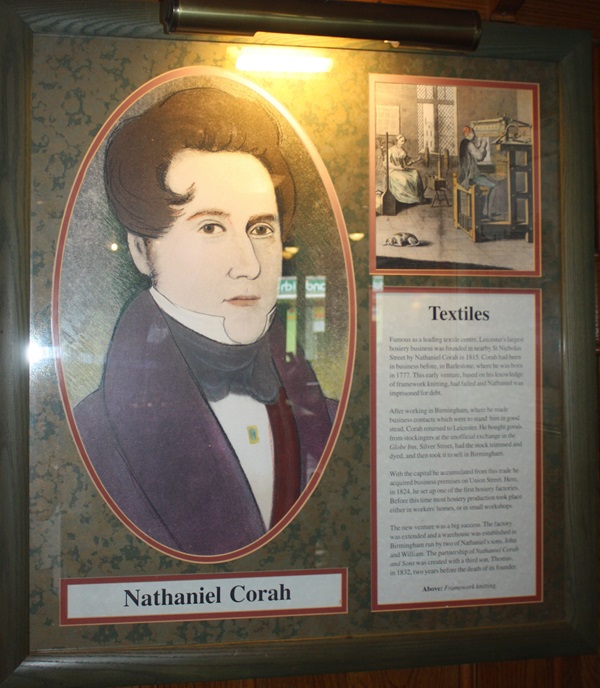
The text reads: Famous as a leading textile centre, Leicester largest hosiery business was founded in nearby St Nicholas Street by Nathaniel Corah in 1815. Corah had been in business before, in Barlestone where he was born in 1777. This early venture, based on his knowledge of framework knitting had failed and Nathaniel was imprisoned for debt.
After working in Birmingham, where he made business contacts which were to stand him in good stead, Corah returned to Leicester. He bought goods from stockingers at the unofficial exchange in the Globe Inn, Silver Street, had the stock trimmed and dyed, and then took it to sell in Birmingham
With the capital he accumulated from this trade he acquired business premises on Union Street. Here, in 1824, he set up one of the first hosiery factories. Before this time most hosiery production took place either in workers homes, or in small workshops.
The new venture was a big success. The factory
was extended and a warehouse was establish
in Birmingham run by two of Nathaniel's sons, John and William. The partnership of Nathaniel Corah and Sons was created with a third son, Thomas, in 1832, two years before the death of its founder.
Above: Framework knitting.
Prints and text about Highcross Coffee House.

The text reads: The site of this pub was once occupied by the Highcross Coffee House where tea, coffee, and cocoa were available from 5am until 11pm, at one (old) penny per pint. It was one of a chain of a dozen temperance establishments owned by the Leicester Coffee and Cocoa House Company, whose Eastgates and Victoria Coffee Houses have survived.
The company was the inspiration of the Chairman of the Midland Railway Company, Edward Ellis. For a time, the Coffee Houses were fashionable amongst middle-class ladies, but after the First World War business declined and the Company folded in 1921.
The Temperance Movement had originated in the USA in 1826 reaching this country five years later, when the British and Foreign Temperance Society was formed. The pioneer travel-agent Thomas Cook was a strong supporter of the movement. His first railway excursion in 1841 was a trip from Leicester to a temperance rally in Loughborough. His Temperance Hotel, opened in 1853, still stands on Granby Street.
Left: top, this building (now Wetherspoon's) can be seen on the left, on the corner of the High Street, below, the Victoria Coffee House.
Right: Thomas Cook
Far right: William Hogarth's satirical views of drinking beer and gin.


Prints and paintings of the West Bridge.

Left and Above: West Bridge, c.1820
Below: The Victorian West Bridge, opened in 1891.
Prints of High Street.

Above: Widening of the High Street in 1902
Middle: Huntingdon Tower (left), and High Street c1900 & laying tramlines around the Clock Tower, 1903
Below: The Clock Tower, 1868.
A photograph of High Street, Leicester, c.1910.

A photograph of High street, Leicester, c.1905.
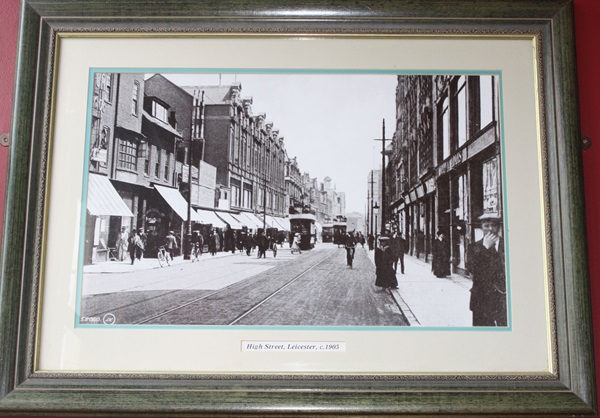
A photograph of East Gate, Leicester, c.1905.
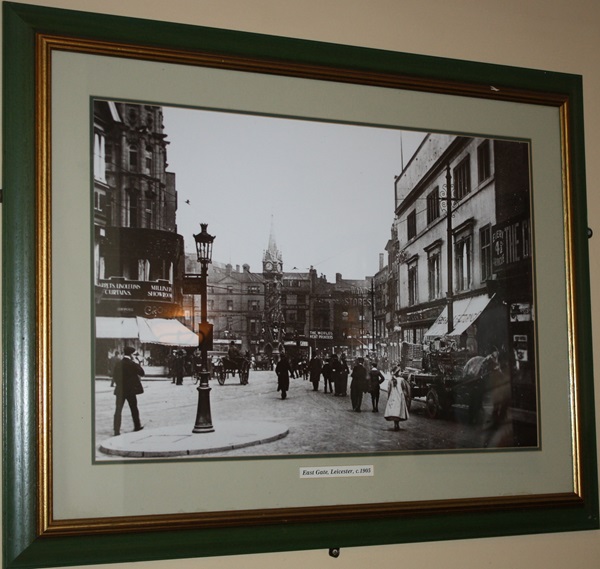
A photograph of St. Mary’s Church, Leicester, C.1900.

A photograph of Midland Station, Leicester, c. 1914.

A photograph of a view from Market Place, Leicester, c.1950.

A photograph of High street, Leicester, c.1950.

A photograph of the junction of High Street and High Cross Street (this site on left).
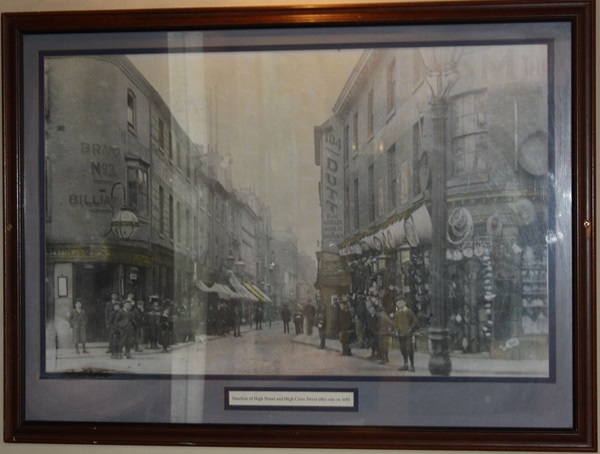
Illustrations of the Old Golden Lion Inn, Highcross Street and the Old Grammar School. A photograph of Highcross Street, c.1959.
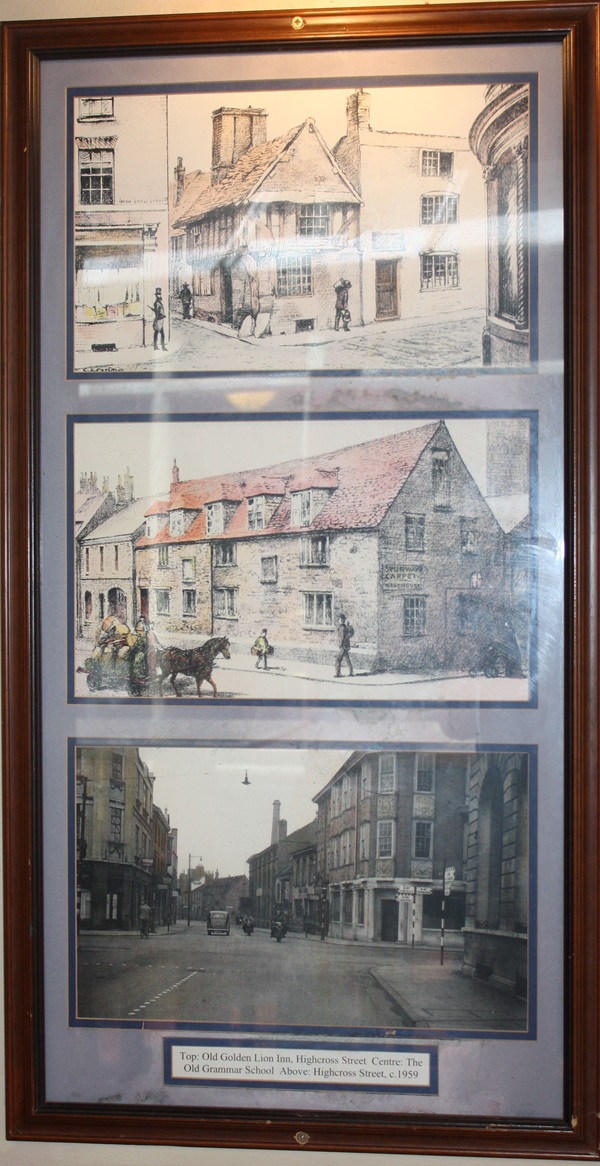
The last remaining pillar of the High Cross.
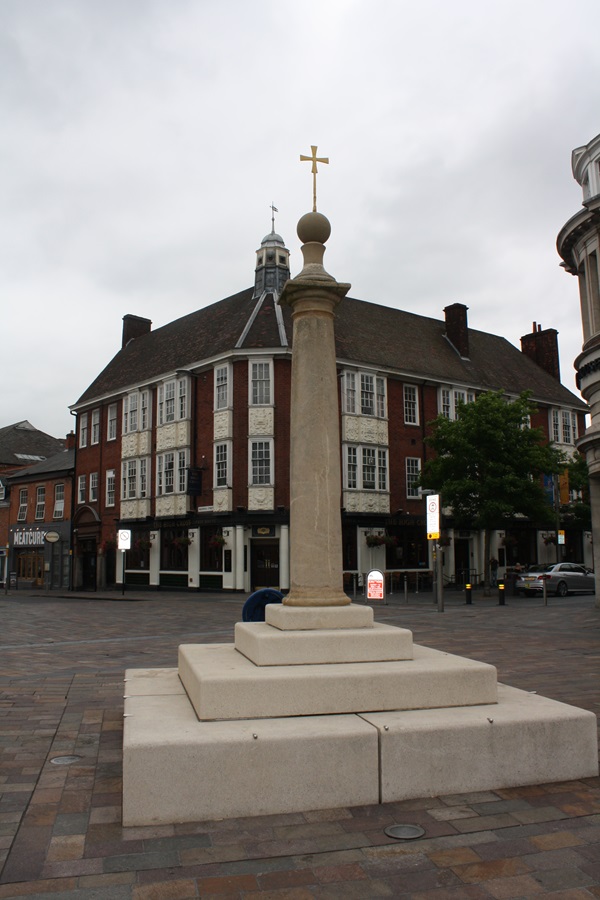
The pub can be seen in the background.
External photograph of the building – main entrance.
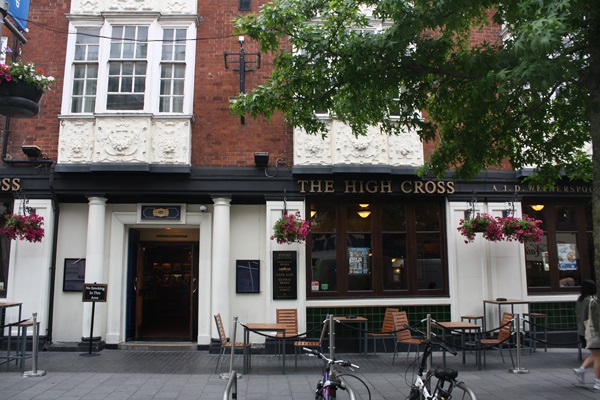
If you have information on the history of this pub, then we’d like you to share it with us. Please e-mail all information to: pubhistories@jdwetherspoon.co.uk